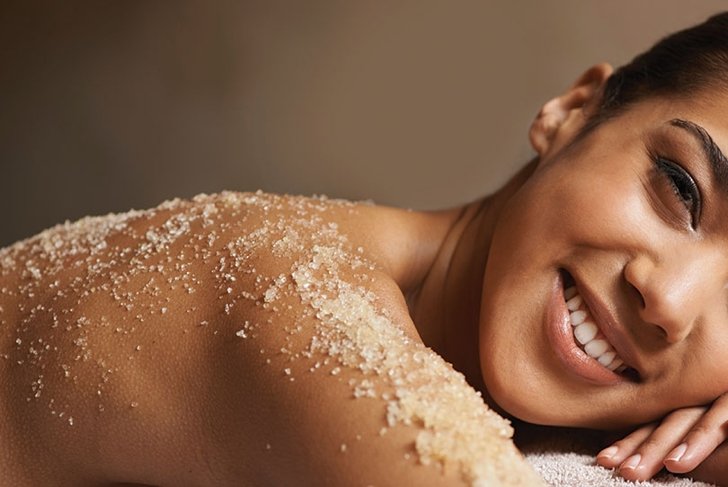
Springtime is the perfect time to renew and refresh your skin care routine. Exfoliation and dry brushing can get rid of dull winter skin and leave you glowing—try these techniques to get your skin short-season ready.
Ready to bare all for spring? It’s time to come out of hibernation and get glowing, healthy skin for the warmer months. Thankfully, it’s very simple: your secret weapon for smooth skin and a radiant complexion is exfoliation!
Why exfoliate?
Essentially, exfoliation means removing the dead skin cells sitting on the top layer of skin. When we have dry, flaky skin, such as in the winter, it also means we have more skin cells that can be removed by exfoliating, so spring is the perfect time to exfoliate. While some exfoliation treatments are meant for a dermatologist’s office or a spa, it’s easy and effective to exfoliate your skin gently at home.
Benefits
- Smoother skin: Since exfoliating helps to slough off dry and dead skin cells, it can result in smoother, softer skin.
- Even skin tone: Many people find that exfoliation can help brighten their skin tone and remove the dullness and dark spots that are caused by a buildup of flaky patches.
- Increased circulation: By massaging the skin, exfoliating can help improve blood and lymph circulation, providing an instant pick-me-up for our complexions.
- Fewer ingrown hairs: If you’re prone to ingrown hairs, you may find that regular exfoliation can help prevent pesky ingrowns from developing in the first place, as well as lessen the appearance of dark spots and thickened skin that ingrown hairs can cause.
Easy does it!
Rule number one when exfoliating is to be gentle on your skin. For most people, exfoliating once a week should be sufficient. If you have sensitive skin, proceed with caution, and if you’re in the middle of an acne breakout (or if your skin is broken or irritated), skip exfoliating altogether until your skin has cleared up—the friction caused by exfoliation can make breakouts worse.
If you’re not sure if exfoliation is for you, check with a health care practitioner or dermatologist first.
Types of exfoliation
There are two main types of exfoliation: mechanical and chemical.
Mechanical
Also known as physical exfoliation, mechanical exfoliation is simply caused by friction—either by a tool such as a loofah or washcloth against the skin, or by an exfoliating scrub. Read the specific product instructions to be sure, but generally, mechanical exfoliating products are meant to be massaged into skin in gentle circular motions (either with your fingers or with a tool) and then rinsed off with warm water.
Chemical
While the term “chemical” can have a negative connotation for us health-conscious folk, it shouldn’t in this case—all it means is that the product itself is doing the work, rather than the friction caused by using a scrub.
Two common types of chemical exfoliants, alpha hydroxy acids (AHAs) and beta hydroxy acids (BHAs), are actually naturally derived, such as from apples and grapes, and have many benefits. AHAs, for instance, are thought to stimulate the growth of new skin cells and increase collagen.
However, AHAs and BHAs are thought to increase sensitivity to the sun, so be sure to wear a good quality natural sunscreen, be sun smart, and start with a low concentration.
- Campaign for Safe Cosmetics safecosmetics.org
- David Suzuki Foundation davidsuzuki.org
- Environmental Defence environmentaldefence.ca and justbeautiful.ca
- Environmental Working Group’s Skin Deep database ewg.org/skindeep
Head-to-toe exfoliation
Exfoliate from your lips to the tips of your toes with the following advice and tools.
Lips
Tips and tricks: Sometimes lip balm isn’t enough to get rid of annoying flaky patches. If you’re battling chapped lips, try a natural lip scrub. Massage it in a circular motion on your lips with your finger or a soft washcloth, and then remove with warm water and apply a natural lip balm.
Star ingredients: Cane sugar is a gentle exfoliant for lips, and—let’s face it—it’s a delicious win-win!
Face and neck
Tips and tricks: Our faces receive the brunt of the winter elements, so there can be plenty of dry, flaky patches to polish away. However, our faces typically also have thin skin and can be sensitive, so it’s important to be gentle. And don’t forget to exfoliate your décolletage, or neck and collarbone area!
Star ingredients: Not all exfoliants are gentle enough for use on delicate face and neck skin. For example, oatmeal, rice bran, and jojoba beads are wise choices, while crushed walnut or apricot pits may be too abrasive.
AHA- and BHA-based exfoliants are commonly found in products formulated for the face. BHAs, for example, are thought to work well on oily skin, making them great for those suffering from acne. A natural source of BHA is willow bark, which is an ingredient in some natural skin care products for those with acne-prone skin.
Hands and body
Tips and tricks: Exfoliate your hands, chest, back, arms, and legs in the shower for a no-mess, at-home spa day. Use a loofah, soft washcloth, natural sponge, or your hands, depending on the amount of abrasion you’d like.
Star ingredients: Consider a salt-, sugar-, bamboo-, or oatmeal-based scrub. There are plenty of natural options available at natural health retailers, so ask the knowledgeable staff what works best for your unique skin concerns.
Feet
Tips and tricks: Since feet have thicker skin than other parts of our body, products that are slightly more abrasive can be used—and you can swap out your soft washcloth for a pumice stone on heels and soles.
Star ingredients: Peppermint can be invigorating and refreshing—not to mention deodorizing—on feet, making it a great choice for foot scrubs. Some foot scrubs even contain crushed pumice stone for particularly stubborn skin.
What about dry brushing?Dry brushing is a technique that’s thought to help boost circulation, improve skin tone, and exfoliate the body—plus, it feels great! Some people find that it even helps reduce the appearance of cellulite.
Invest in a soft body brush designed for dry brushing from your local health food store, and use it before showering to make long, sweeping strokes along your body toward your heart.
Extra tips for smooth skin
- Moisturize, moisturize, moisturize! While you may wish to switch from a heavy cream to a lighter lotion in the warmer months, it’s still very important to keep skin soft and supple with a good quality natural moisturizer. The best time to do so is directly after showering or bathing, shaving, or exfoliating. Natural oils such as olive or jojoba can also be great for dry skin.
- Limit the time you spend in hot showers or baths, as hot water can contribute to dry skin.
- If your skin is particularly sensitive or dry, opt for fragrance-free lotions and soaps.
- Wear gloves when washing the dishes—the hot water and detergent can damage dry or sensitive skin.
Small package, big environmental problems
No matter what part of your body you’re exfoliating, take extra caution to ensure that the product you choose doesn’t contain small plastic beads as an exfoliant.
Researchers have found that these tiny plastic pieces don’t break down; rather, they make their way down the drain and into waterways, where they absorb toxic chemicals. Unfortunately, these plastic beads look like tasty treats to animals such as sea turtles and fish, which can ingest them and suffer problems.
To steer clear of these problematic plastic pollutants, avoid any ingredients called “polyethylene.”













